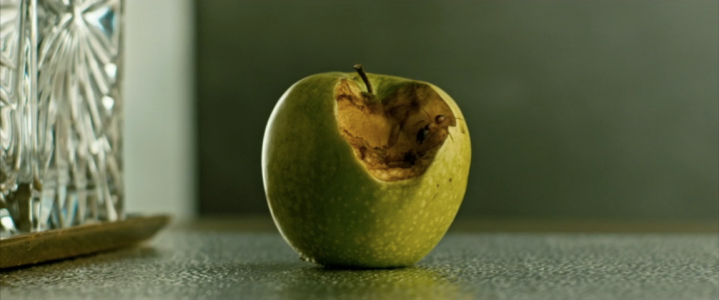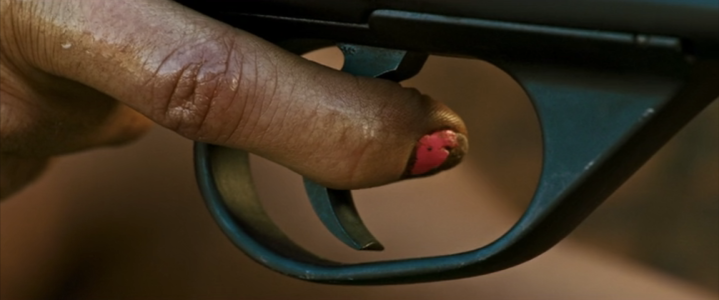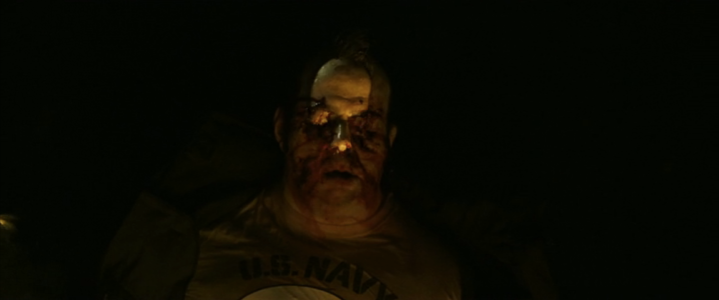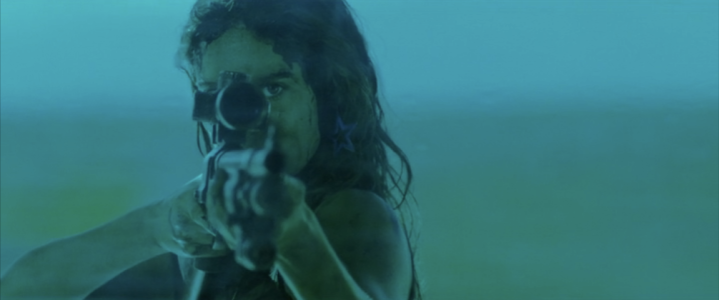Revenge. 2018. Directed & Written by Coralie Fargeat.
Starring Matilda Anna Ingrid Lutz, Kevin Janssens, Vincent Colombe, & Guillaume Bouchède.
M.E.S. Productions/Monkey Pack Films/Charades
Rated R. 108 minutes.
Action/Thriller
★★★★
 If there’s any sub-genre begging to lurch into obscurity, it’s that of rape-revenge. There are some, such as Wes Craven’s 1972 shocker The Last House on the Left, better than others. Then there are the really bad ones: the 2009 remake of The Last House on the Left, the 2010 remake of I Spit on Your Grave, an endless number of indie horror-thrillers just out to shock and without an intelligent thing to say. On top of it all, at least 95% of these rape-revenge movies— if not closer to 99%— are written and directed by men. We’re left with a heap of movies with a first half focused on the brutalisation and rape and victimisation of women, supposedly redeemed, more oft than not, by a second half filled with the woman— or, worse, many times a man— taking bloody revenge on the rapists.
If there’s any sub-genre begging to lurch into obscurity, it’s that of rape-revenge. There are some, such as Wes Craven’s 1972 shocker The Last House on the Left, better than others. Then there are the really bad ones: the 2009 remake of The Last House on the Left, the 2010 remake of I Spit on Your Grave, an endless number of indie horror-thrillers just out to shock and without an intelligent thing to say. On top of it all, at least 95% of these rape-revenge movies— if not closer to 99%— are written and directed by men. We’re left with a heap of movies with a first half focused on the brutalisation and rape and victimisation of women, supposedly redeemed, more oft than not, by a second half filled with the woman— or, worse, many times a man— taking bloody revenge on the rapists.
And it’s all captured through the lens of the male gaze.
What makes Revenge different immediately is that it’s both directed and written by a woman, Coralie Fargeat (whose fantastic short Reality+ is a must-see if you get the chance). Instead of seeing what the typical rape-revenge movie looks like through a perspective of men envisioning the trauma and vengeance of women, this story challenges the male gaze. Fargeat’s feminine perspective allows the audience to see this exploitative sub-genre from the POV of a woman, wholly. Instead of focusing on physical degradation, Revenge hammers home all the many ways in which women are degraded by men, wrapped up in a story involving a rape and, of course, the revenge.

“But you’re so damn beautiful, too,
it’s hard to resist you…”
 One of Fargeat’s compelling and efficient techniques is her use of imagery and symbolism throughout the whole movie, right from early on. Take the apple, turning up in several shots particularly after our leading lady, Jen (Matilda Anna Ingrid Lutz) – perhaps the most significant image, in terms of what the story touches on thematically. This is the first suggestion of not only a jab at the rape-revenge sub-genre, but likewise a finger in the eye of Christianity and its role in historical misogyny.
One of Fargeat’s compelling and efficient techniques is her use of imagery and symbolism throughout the whole movie, right from early on. Take the apple, turning up in several shots particularly after our leading lady, Jen (Matilda Anna Ingrid Lutz) – perhaps the most significant image, in terms of what the story touches on thematically. This is the first suggestion of not only a jab at the rape-revenge sub-genre, but likewise a finger in the eye of Christianity and its role in historical misogyny.
We all know the Biblical story of Adam and Eve, the Garden of Eden, Satan as the snake goading Eve into biting the apple and in turn she apparently convinced him to have a taste, then they were banished. Well, the apple is historically used to refer back— often with misogynistic shades— to Eve, and in a broader sense the Christian belief that Original Sin links back to the actions of a woman.
Fargeat employs the apple, with a single bite taken out of it, as a symbol of how women take the blame for things that aren’t their fault. If Adam bit that apple in the Garden of Eden, he did of his own free will, not because of Eve. Just the same as rape is all too frequently blame on women— what they wore, how they acted, how much they drank, and so on. Thus, the apple becomes even more significant after the rape, sitting there rotting, a perpetual reminder of hideous men blaming their vicious actions on women. And that’s exactly what happens to poor Jen: blamed for her own rape, and blamed for possibly complicating the marriage of Richard (Kevin Janssens) even though he’s the one who’s married and she’s a single woman with free will, therefore she’s basically being blamed for having to be hunted down and killed. However, the apple isn’t the only Biblical reference in Revenge.
 Other important Biblical images:
Other important Biblical images:
1) The burning bush: this one doesn’t have an altogether elaborate significance, other than it’s a way of reclaiming Bible imagery in the name of women. So, the burning bush here is not about some ridiculous, blind faith devotion to a god, to the point of nearly killing your own child, it instead becomes an image that’s part of Jen’s ultimate salvation and escape from the clutches of men, fate, and death.
2) Virgin Mary painting: although it isn’t definitively a Virgin Mary, the painting in Richard’s getaway house is absolutely similar to her typical depictions. Here, it’s a pop art version of her image with bright colours and lipstick drawn on. This postmodern painting is transformed, via context with the general aim at Biblical symbolism, into a bastardised image of woman— more so, it’s a revered woman, and so the bastardisation of a holy woman is on the level of blasphemy. The fact the painting is hung in Richard’s place is not insignificant, either.
3) Man as reptile: in moments where Jen is seeking revenge, back in the company of her would-be murderers, the editing uses fantastic little shots interspersed with the men, juxtaposing man and reptile. This ties into the rest of the Christian symbolism, man as snake, too. And this is the perfect full circle for the entire thematic link to the Garden of Eden and the apple.
 A huge reason why Revenge bucks the trend of other similar movies in the sub-genre is because Fargeat opts to show the audience more of the woman at the centre of the story itself. There’s no massive focus on the degrading physical act of the rape itself, despite a brief scene. The majority of the degradation of women seen in the movie is that of mental, emotional, social, and spiritual degradation women face, every single day— this is just a microcosm.
A huge reason why Revenge bucks the trend of other similar movies in the sub-genre is because Fargeat opts to show the audience more of the woman at the centre of the story itself. There’s no massive focus on the degrading physical act of the rape itself, despite a brief scene. The majority of the degradation of women seen in the movie is that of mental, emotional, social, and spiritual degradation women face, every single day— this is just a microcosm.
Perhaps the scene best exemplifying this is when Jen spends the night in a cave by herself, after dragging herself off the tree that impaled her. She takes a bit of peyote that survived along with her, taking her into a psychedelic mental space where she sees horrifying visions. This scene is like a crash course in PTSD, as Jen sees her abusers’ faces, the face of the one she recently killed, mixed in with some of the reptilian imagery.
Revenge never leaves out all the facets of a woman’s experience with rape and sexual assault. Jen goes through different emotional stages during the cave scene, including the mental effects of killing someone – regardless if getting revenge, killing another person causes trauma, as well. So often we don’t see the process of a woman’s emotional state in these rape-revenge movies, it’s always a straight line from the rape to the revenge, rather than exploring any nuance as Fargeat does in this story. Fittingly, Jen has to cauterise a wound in the cave, leaving her with a Mexican beer logo in the shape of a phoenix, symbolising her own rise from the figurative and literal ashes heading towards her revenge.

 While, yes, the rape is depicted, the focus of Revenge – unlike exploitation flicks in the ’60s and ’70s, though not solely relegated to those decades – lies in detailing the hypocrisy of men, the victimisation of Jen due to her beauty and gender, as well as the eventual revenge she visits on the men who’ve wronged her so violently.
While, yes, the rape is depicted, the focus of Revenge – unlike exploitation flicks in the ’60s and ’70s, though not solely relegated to those decades – lies in detailing the hypocrisy of men, the victimisation of Jen due to her beauty and gender, as well as the eventual revenge she visits on the men who’ve wronged her so violently.
Fargeat’s not trying to nullify a sub-genre, because fiction and art should never impose such rigid limits on itself. She actually seems to want to help reinvent it, or, at the very least, trying to shove it in a better direction where the focus becomes a little more humanised. Right now, and since its beginning, the rape-revenge sub-genre has centred around the male gaze.
With Revenge, the woman isn’t portrayed through such a lens, and when she is it’s to serve a point Fargeat hopes to make. The finale is a perfect show of this, where Richard is put in the position other movies of this ilk put the woman as a victim – naked and fighting for his life in a virtual labyrinth of blood. Tweaks to the typical formula are what Fargeat does best, by gradually changing certain tropes and using others to her advantage. Crossing a few fingers she’ll continue blazing a path for women both behind and in front of the camera in genre cinema.


Joins the ranks of I SPIT ON YOUR GRAVE (1978) and MS. 45 (1981) as a rape/revenge genre great
LikeLiked by 1 person